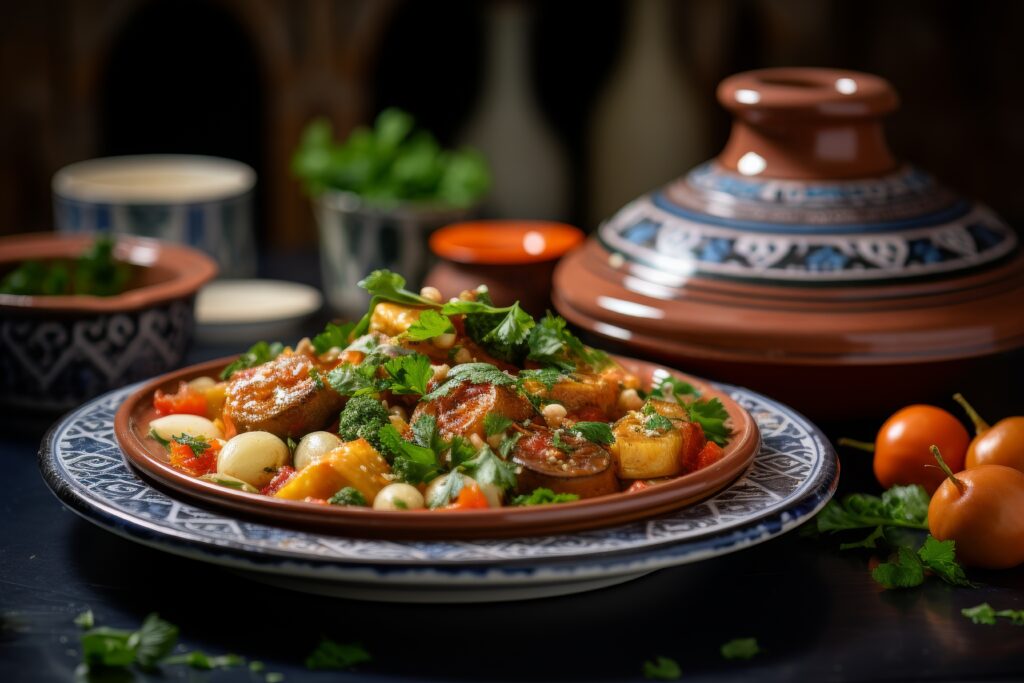
Moroccan Vegetable Tagine: A Wholesome North African Delight
Moroccan Vegetable Tagine is a vibrant and aromatic dish that embodies the rich culinary heritage of Morocco. Packed with an array of colourful vegetables, spices, and dried fruits, this dish is a celebration of flavors and textures. Traditionally cooked in a conical earthenware pot called a tagine, this dish is both comforting and elegant. Chef Abdul, an expert in North African cuisine, shares his recipe and tips for creating the perfect Moroccan Vegetable Tagine. Whether served with couscous or flatbread, this dish is sure to delight your taste buds.
The History of Tagine
Tagine refers both to the cooking vessel and the dishes prepared in it. Originating in North Africa, tagines are slow-cooked meals that blend savory and sweet flavors. The method of cooking in a tagine—which traps steam and enhances flavors—dates back centuries and is a hallmark of Moroccan culinary traditions.
“Moroccan Vegetable Tagine is a reflection of the country’s rich history, where spices and ingredients from across the world come together in perfect harmony,” says Chef Abdul.
Ingredients
For the Tagine Base:
- 2 tablespoons olive oil
- 1 large onion, finely chopped
- 3 garlic cloves, minced
- 1 teaspoon ground ginger
- 1 teaspoon ground cinnamon
- 1 teaspoon ground cumin
- 1/2 teaspoon ground turmeric
- 1/4 teaspoon cayenne pepper (optional)
- Salt and black pepper to taste
For the Vegetables:
- 2 medium carrots, sliced
- 1 medium zucchini, sliced
- 1 medium eggplant, cubed
- 1 cup butternut squash, cubed
- 1 red bell pepper, sliced
- 1 cup chickpeas (cooked or canned, drained)
- 1/2 cup dried apricots, chopped
- 1/4 cup raisins
- 1 can (400g) diced tomatoes
- 1/2 cup vegetable stock
For Garnish:
- 1/4 cup fresh parsley, chopped
- 1/4 cup fresh cilantro, chopped
- Toasted almonds or sesame seeds (optional)
Method to Make Moroccan Vegetable Tagine
- Sauté the Aromatics:
- Heat olive oil in a large tagine or heavy-bottomed pot over medium heat. Add the onion and garlic and sauté until softened.
- Toast the Spices:
- Stir in ginger, cinnamon, cumin, turmeric, cayenne (if using), salt, and pepper. Cook for 1-2 minutes to release the aromas.
- Add the Vegetables:
- Layer the carrots, zucchini, eggplant, butternut squash, and bell pepper over the aromatics. Stir gently to coat the vegetables in the spices.
- Incorporate Liquids and Fruits:
- Add the diced tomatoes, vegetable stock, chickpeas, apricots, and raisins. Stir gently, ensuring the liquid covers most of the vegetables.
- Simmer:
- Reduce the heat to low, cover with the tagine lid or pot cover, and let simmer for 30-40 minutes, or until the vegetables are tender and the flavors are well combined. Stir occasionally to prevent sticking.
- Garnish and Serve:
- Sprinkle with fresh parsley, cilantro, and toasted almonds or sesame seeds if desired. Serve warm with couscous, quinoa, or flatbread.
Tips for Success
- Use Fresh Spices: Freshly ground spices enhance the depth of flavor in the tagine.
- Layering: Layer the vegetables strategically, placing harder vegetables like carrots and squash at the bottom to ensure even cooking.
- Tagine or Pot: If you don’t have a tagine, a heavy-bottomed pot or Dutch oven works perfectly.
Pairings for Moroccan Vegetable Tagine
- Couscous: Fluffy couscous is the traditional accompaniment.
- Flatbread: Serve with warm pita or Moroccan bread to scoop up the sauce.
- Salad: Pair with a refreshing cucumber and mint salad.
- Tea: A glass of Moroccan mint tea complements the meal beautifully.
Conclusion
Moroccan Vegetable Tagine is a hearty and flavorful dish that captures the essence of North African cuisine. Chef Abdul’s recipe ensures a perfectly balanced tagine with aromatic spices, tender vegetables, and a touch of sweetness from dried fruits. Whether you’re hosting a dinner party or preparing a comforting family meal, this dish is sure to impress.
As Chef Abdul puts it, “A good tagine is a journey through Morocco’s vibrant markets and timeless culinary traditions. It’s a dish that warms both the heart and soul.”

